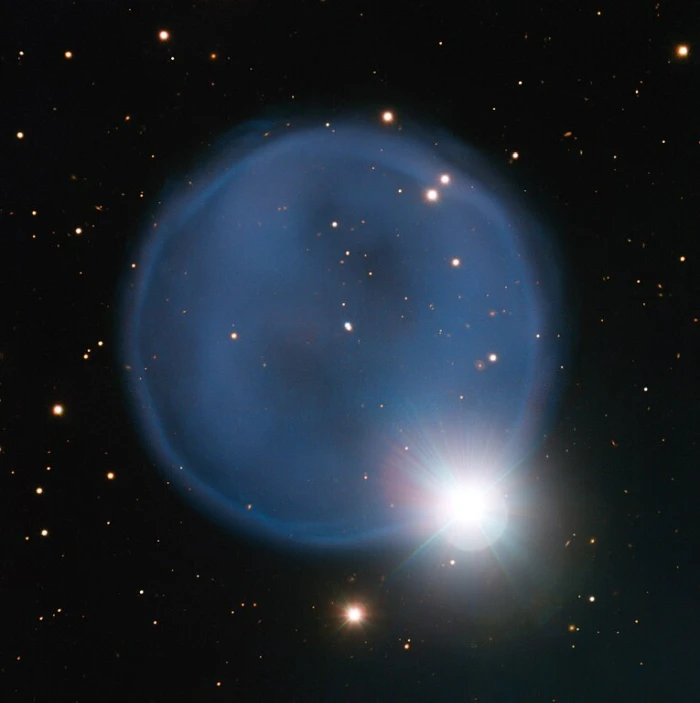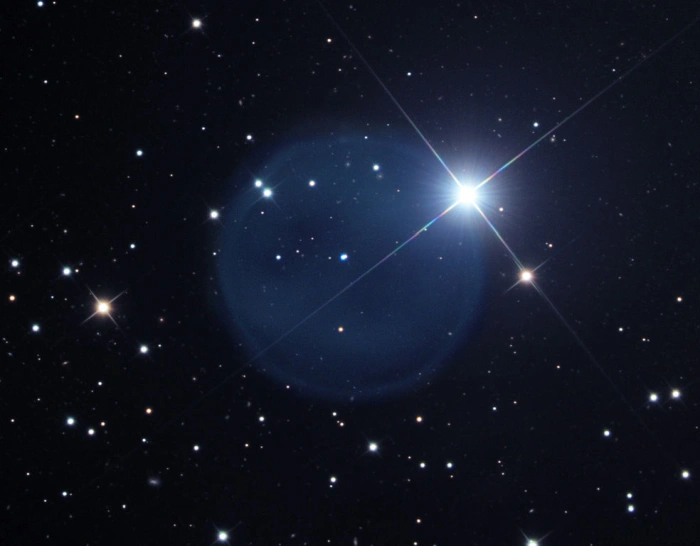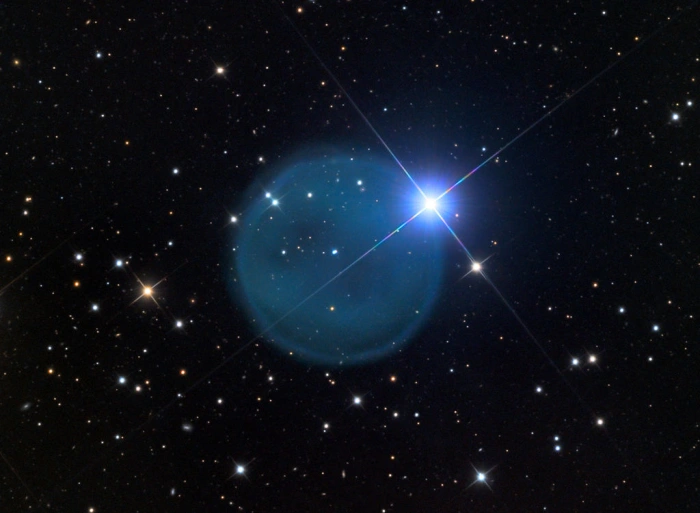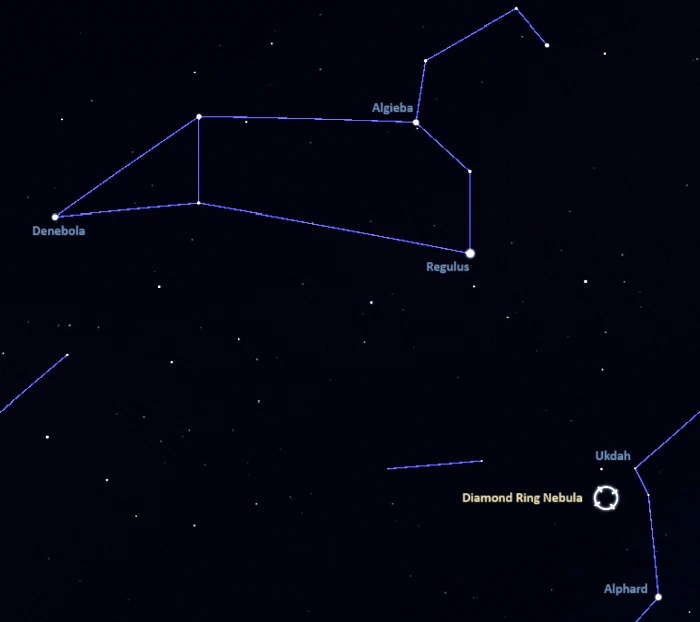The Diamond Ring Nebula (Abell 33, A33) is a planetary nebula located approximately 2,700 light-years away in the constellation Hydra. The circular nebula lies behind the foreground star HD 83535, which gives the nebula the appearance of a diamond ring. The nebula and the star are not related. The star lies much closer to us.
Like all planetary nebulae, the Diamond Ring formed when an evolved red giant star came to the end of its evolutionary cycle and expelled its outer layers into space. Now, the ejected gaseous envelope is ionized by the intense ultraviolet light of the hot stellar remnant. The glowing shell of ionized gas will dissipate in the next few thousand years and the progenitor star will slowly cool and fade as a dim white dwarf for billions of years.
The Diamond Ring Nebula appears blue because of OIII emissions. Once believed to be a new element called nebulium, doubly ionized oxygen (OIII) is common in planetary nebulae. It was first detected in the spectrum of a planetary nebula in the 1864, when the English astronomer and spectroscopy pioneer William Huggins discovered it in the spectrum of the Cat’s Eye Nebula (NGC 6543) in the constellation Draco.

Astronomers using ESO’s Very Large Telescope in Chile have captured this eye-catching image of planetary nebula Abell 33. Created when an aging star blew off its outer layers, this beautiful blue bubble is, by chance, aligned with a foreground star, and bears an uncanny resemblance to a diamond engagement ring. This cosmic gem is unusually symmetric, appearing to be almost perfectly circular on the sky. Most stars with masses similar to that of our Sun will end their lives as white dwarfs — small, very dense, and hot bodies that slowly cool down over billions of years. On the way to this final phase of their lives the stars throw their atmospheres out into the space and create planetary nebulae, colourful glowing clouds of gas surrounding the small, bright stellar relics.
This image, captured by ESO’s Very Large Telescope (VLT), shows the remarkably round planetary nebula Abell 33. Being perfectly round is uncommon for these objects — usually something disturbs the symmetry and causes the planetary nebula to display irregular shapesImage credit: ESO (CC BY 4.0)
The spherical shape of the Diamond Ring Nebula is rare in planetary nebulae. Astronomers explain it with the absence of spin of the central star. Other spherical nebulae include the Owl Nebula (Messier 97) in the constellation Ursa Major, the Southern Owl Nebula (ESO 378-1) in Hydra, Abell 39 in Hercules, and NGC 6742 in Draco.
The Diamond Ring Nebula has a similar morphology to the better-known Owl Nebula (Messier 97) in the region of the Big Dipper. However, unlike the cosmic Owl, which can be seen in a small telescope in good conditions, the Diamond Ring Nebula is faint and makes a challenging target for backyard instruments.
The nebula’s central star has the spectral class DAO. It was previous classified as O(H) and sd Op. A 2018 study found that it had similar wide absorption lines to white dwarf stars (WD).
The star HD 83535 appears aligned with the nebula’s rim. With an apparent magnitude of 7.21, it is invisible to the unaided eye. It lies 700 light-years away. The star is similar to Sirius in temperature and mass. It is a main sequence star of the spectral type A1 V.
More recent measurements obtained in the Gaia Data Release 3 (GDR3) place the star much farther away, at a distance of 1,018 light years, but even at this distance HD 83535 would not be related to the nebula.

Diamond Ring Nebula, image credit: Wikimedia Commons/JSchulman555 (CC BY-SA 3.0)
Facts
The Diamond Ring Nebula was discovered by the American astronomer George Ogden Abell on the photographic plates obtained in the National Geographic Society – Palomar Observatory Sky Survey (POSS) at Palomar Observatory in California in 1955. The photographs were taken with the 48-inch Samuel Oschin telescope. Abell included the nebula as A55 22 (object number 22) on his list of deep sky objects published in 1955.
The nebula is listed as A66 33 in the final version of the Abell Catalogue of Planetary Nebulae, published in 1966. It is not to be mistaken for the Abell catalogue of galaxy clusters, which includes the cluster Abell 33 in the constellation Cetus.

Diamond Ring Nebula, credit: Adam Block/Mount Lemmon SkyCenter/University of Arizona (CC BY-SA 3.0 US)
Location
The Diamond Ring Nebula lies in the constellation of Hydra, near the border with Sextans. It appears along the imaginary line drawn from Alphard, the brightest star in Hydra, to Regulus in the constellation Leo. The nebula lies south of the relatively bright orange star Ukdah (Iota Hydrae). Ukdah has an apparent magnitude of 3.9 and is located about 8 degrees north-northwest of Alphard.
The Diamond Ring Nebula is faint, which makes it a difficult target to see in a telescope. However, its unique appearance makes it a popular target for astrophotography.

The location of the Diamond Ring Nebula, image: Stellarium
At declination -02° 48’, the nebula is very close to the celestial equator and visible from both the northern and southern hemispheres.
The best time to observe the Diamond Ring Nebula and other deep sky objects in Hydra is during the month of April, when the constellation appears high above the horizon in the early evening.
Diamond Ring Nebula
| Constellation | Hydra |
| Object type | Planetary nebula |
| Right ascension | 09h 39m 09.1418645928s |
| Declination | −02° 48′ 30.486998664″ |
| Apparent magnitude | 12.9 |
| Apparent size | 4.467’ x 4.467’ |
| Distance | 2,700 light years (830 parsecs) |
| Names and designations | Diamond Ring Nebula, Abell 33, PN A66 33, PK 238+34.1, PN A55 22, ARO 65, PN VV’ 91, PN G238.0+34.8, PG 0936-026, CSI-02-09366, GALEX J093909.1-024829, GALEX J093909.2-024830, GALEX J093908.9-024830, UBV 9180, UBV M 44665, GEN# +6.20056033, GSC 04897-00194, IRAS F09365-0234, SDSS J093909.14-024830.3, ULAS J093909.13-024830.4, ULAS J093909.13-024830.6, Gaia DR2 3827045525522912128, Gaia DR3 3827045525522912128, WDS J09392-0247A |